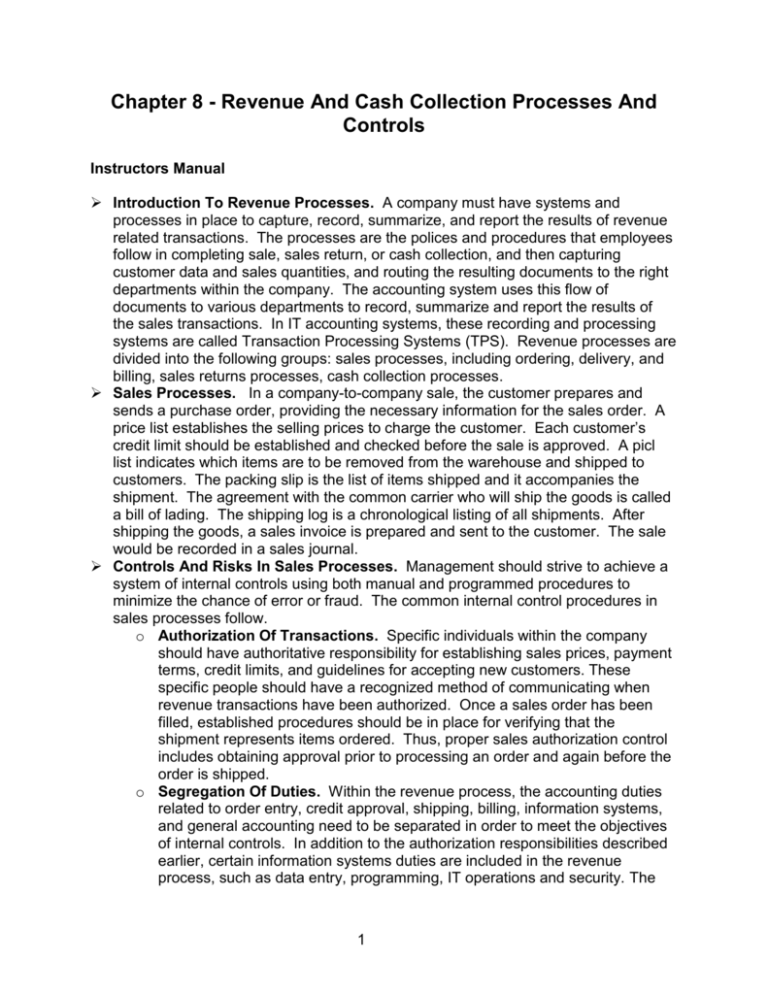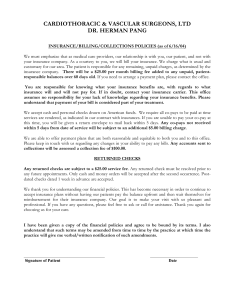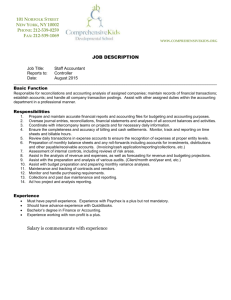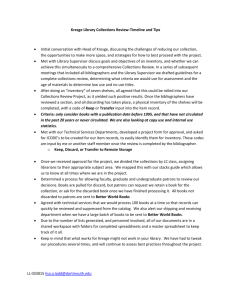Chapter 8 - Revenue And Cash Collection Processes
advertisement

Chapter 8 - Revenue And Cash Collection Processes And Controls Instructors Manual Introduction To Revenue Processes. A company must have systems and processes in place to capture, record, summarize, and report the results of revenue related transactions. The processes are the polices and procedures that employees follow in completing sale, sales return, or cash collection, and then capturing customer data and sales quantities, and routing the resulting documents to the right departments within the company. The accounting system uses this flow of documents to various departments to record, summarize and report the results of the sales transactions. In IT accounting systems, these recording and processing systems are called Transaction Processing Systems (TPS). Revenue processes are divided into the following groups: sales processes, including ordering, delivery, and billing, sales returns processes, cash collection processes. Sales Processes. In a company-to-company sale, the customer prepares and sends a purchase order, providing the necessary information for the sales order. A price list establishes the selling prices to charge the customer. Each customer’s credit limit should be established and checked before the sale is approved. A picl list indicates which items are to be removed from the warehouse and shipped to customers. The packing slip is the list of items shipped and it accompanies the shipment. The agreement with the common carrier who will ship the goods is called a bill of lading. The shipping log is a chronological listing of all shipments. After shipping the goods, a sales invoice is prepared and sent to the customer. The sale would be recorded in a sales journal. Controls And Risks In Sales Processes. Management should strive to achieve a system of internal controls using both manual and programmed procedures to minimize the chance of error or fraud. The common internal control procedures in sales processes follow. o Authorization Of Transactions. Specific individuals within the company should have authoritative responsibility for establishing sales prices, payment terms, credit limits, and guidelines for accepting new customers. These specific people should have a recognized method of communicating when revenue transactions have been authorized. Once a sales order has been filled, established procedures should be in place for verifying that the shipment represents items ordered. Thus, proper sales authorization control includes obtaining approval prior to processing an order and again before the order is shipped. o Segregation Of Duties. Within the revenue process, the accounting duties related to order entry, credit approval, shipping, billing, information systems, and general accounting need to be separated in order to meet the objectives of internal controls. In addition to the authorization responsibilities described earlier, certain information systems duties are included in the revenue process, such as data entry, programming, IT operations and security. The 1 custody function includes inventory handling and preparing goods for shipment. Ideally, good internal controls within the sales process require that accounting for inventory is completely separate from inventory handling. Also, any person who maintains detailed accounts receivable records should not also be responsible for maintaining the general ledger or handling cash. o Adequate Records And Documents. Those responsible for recording sales should ensure that supporting documentation is retained and organized. As records are prepared, they should be compared with supporting information to make sure they are accurate and to prevent duplication. Sales orders, shipping logs, invoices, customer account statements, and other related documents should be saved and filed. Maintaining good records also facilitates the performance of independent checks and reconciliations. o Security Of Assets And Documents. Inventory should be protected by using physical controls in the warehouse. Some examples of physical controls include surveillance cameras, security guards and/or alarm systems. Likewise, data files, production programs, and accounting records should each be protected from unauthorized access. Passwords, backup copies, and physical controls (such as locked file cabinets) can protect a company’s records. o Independent Checks And Reconciliations. Companies should implement procedures whereby independent checks and record reconciliations are performed on a regular basis. These procedures are most effective when they are conducted by someone independent of the related authority, recording, and custody functions. The most common types of independent checks include the verification of information in the sales journal and on sales invoices, the reconciliation of accounts receivable detail with invoices and with the general ledger, and the reconciliation of inventory records with actual (counted) quantities on hand. o Cost/Benefit Considerations. Companies tend to implement internal controls only if they view the benefits of the control as being greater than the costs of carrying out the task. Indications of more risky situations that may require additional controls include: Frequent changes are made to sales prices or customers; The pricing structure is complex or based on estimates; A large volume of transactions is carried out; The company depends on a single or very few key customers; Shipments are made by consignees or are under other arrangements not controlled directly by the company; The product mix is difficult to differentiate; Shipping and/or recordkeeping are performed at multiple locations. Sales Return Processes. A company must have procedures in place for receiving returned goods, crediting the customer’s account, and placing the items back in inventory. When customers return goods, the goods are handled by the receiving department. Returned goods are typically accompanies by documentation from the customer, such as a bill of lading and packing slip. The goods should be inspected for possible damage and a copy of the original sales invoice should confirm the historical sale of the goods. A receiving log is prepared that lists the chronological sequence of all returned items, and a receiving report records the quantity received. 2 A receiving report is a source document completed by personnel in the receiving dock that documents the quantity and condition of items received. If the returned goods are accepted, they are placed back in the proper location in the warehouse and the inventory records are updated to reflect the increase in inventory. A credit memorandum is prepared to document the return and to adjust the amount of the customer’s credit status. A journal of credit memos should be maintained in order to provide a complete listing of all credits issued. Controls And Risks In Sales Return Processes. The following specific controls could be implemented over the sales returns process. o Authorization Of Transactions. Certain designated individuals within the company should be assigned the authority to develop sales return policies, authorize sales returns and approve credit memos. Others within the organization should recognize these specific individuals and should not process returns if they have not been approved by the designated person. o Segregation Of Duties. An effective system of internal controls segregates individuals with authorization duties from those responsible for recording transactions and custody. Ideally, anyone who performs a credit memo activity should not also be responsible for data entry, credit approval, shipping, billing, information systems or general accounting. o Adequate Records And Documents. The reports documenting movement of the goods and the related notification to the customer should be issued sequentially, organized and retained. In addition, it is important to match receiving reports for returns with the respective credit memos in order to ensure that the company issues credit for all returns and for the proper amounts. Returns are also matched with the original sales invoice in order to verify quantities, prices, and item descriptions. Credits for returned goods should also be included in customers’ account statements. o Security Of Assets And Documents. Data files, production programs, and accounts receivable records should be restricted to those who are specifically authorized to approve or record the related transactions. Custody of the related assets should be controlled and limited to those specifically designated to handle the receipts or move the goods. o Independent Checks And Reconciliations. Independent checks include comparing the receiving log with the credit memo listing; verification of recorded descriptions, quantities, dates, prices, and accuracy; comparison of credit memo listing to accounts receivable subsidiary ledger and general ledger posting. o Cost/Benefit Considerations. Some circumstances that may exist within a company that indicate a high level of risk are presented here: Quantities of products returned are often difficult to determine; There is a high volume of credit memo activity; Product prices change frequently or the pricing structure is otherwise complex; Returns are received at various locations or the issuance of credit memos may occur at different locations; The company depends on a single or very few key customers; Returns are received by consignees or under other arrangements not directly controlled by the company. 3 Cash Collection Processes. In the case of company-to-company sales, the sales are typically made on account and a time period is given for the customer to pay. Therefore the timing of a cash collection is that there will be some number of days between invoice date and collection of the cash. When the customer sends a check, the company must have processes in place to properly handle the receipt. It should match the check with the related sales invoice, deposit the funds in a timely manner, and update customer and cash records. Collections from customers typically include a remittance advice, which is the documentation accompanying payment that identifies the customer account number and invoice to which the payment applies. A list of all cash collections is prepared and the checks received are recorded in the cash receipts journal. A cash receipts journal is a special journal that records all cash collections. Controls And Risks In Cash Collection Processes. The following specific controls could be implemented over the cash collection process. o Authorization Of Transactions. Appropriate individuals should be assigned responsibility for opening and closing all bank accounts and approving bank deposits or electronic transfers of funds. This ensures that records are updated only for authorized transactions. o Segregation Of Duties. Separate custody of cash from bank reconciliation. Separate custody of cash from accounts receivable record keeping. Separate cash receipts journal preparation, credit approval, inventory handling, information systems, and general accounting. o Adequate Records And Documents. Cash receipts listings should be prepared on a daily basis so the daily activity of collections should be reconciled to supporting documentation from the bank deposit. Bank deposit receipts should be retained and filed chronologically, and regular, timely bank reconciliations should be prepared and retained. Detailed customer accounts should also be maintained and reconciled with customer statements regularly. o Security Of Assets And Documents. Access to cash collections needs to be limited to those who are expressly authorized to handle cash. Cash collections should be deposited in the bank in a timely manner to prevent the risk of theft. Also, related computerized data files and programs must be protected from unauthorized use. o Independent Checks And Reconciliations. A physical count of cash needs to be conducted from time-to-time in order to compare actual cash on hand with the amounts in the accounting records. Daily bank deposits should also be compared with the detail on the related remittance advice and in the cash receipts journal. In addition, it is important that companies regularly reconcile their cash accounts with the respective bank statements. o Cost/Benefit Considerations. Other circumstances may indicate risks related to cash collections. These include: High volume of cash collections; Decentralized cash collections; Lack of consistency in the volume or source of collections; Presence of cash collections denominated in foreign currencies. IT Enablement Of Revenue And Cash Processes. In many companies today, sophisticated, highly integrated IT systems capture, record and process revenue and 4 cash collection events. E-commerce systems incorporate electronic processing of sales-related activities and generally, e-commerce sales processes are transacted using the Internet. Electronic Data Interchange (EDI) systems communicate sales documents electronically using a standard business format. Point of Sale (POS) systems process sales at a cash register in retail stores. As companies redesign processes to align with these software systems, they conduct business process reengineering to align business processes with the IT systems used to record processes, and to improve efficiency and effectiveness of these processes. There are two kinds of efficiency improvements. First, the underlying processes are reengineered so as to be conducted more efficiently. Second, the IT systems improve the efficiency of the underlying processes. However, the elimination of paper completely changes the audit trail and the internal controls. E-Business Systems And The Risks And Controls. B2C sales are those that most people are familiar with, whereby a retail or service firm sells directly to consumers using a Web site. This is also called e-commerce. B2B sales, on the other hand, involve companies using Web sites to sell products and services to each other. In both B2B and B2C sales, the advantages of e-commerce include: 1. Reduced cost through lower marketing, employee, and paper-work costs. 2. Shorter sales cycles due to reduced time to place an order, deliver the order and collect payment. 3. Increased accuracy and reliability of sales data. 4. Increased potential market for products and services. However, the Internet connected nature of e-commerce sales includes several risks that a company must manage. o Security And Confidentiality Risks. To protect the security of the IT system and the confidentiality of the data, it is important to insure that those accessing the Web site and conducting sales transactions are valid and authorized users. User authentication is an important control for Internet sales when it is possible to use it. In the case of retail sales to end-user consumers, user authentication may not be appropriate. It is important that a company has controls in place to assure that the transaction is with a valid customer, with valid payment authorization, and that an audit trail is maintained to avoid repudiation. Customer authentication through user ID and password should be used. Transactions should be logged and data trails maintained to avoid repudiation. o Processing Integrity Risks. As customers enter data on a Web site to place an order, they can make data entry errors. Controls should be used to minimize these errors. These are programmed data input checks that should be built into any Web based sale systems. The programmed checks should include field checks, validity checks, limit checks, range checks, reasonableness checks, and sign checks. Logging transactions can help establish an audit trail in an electronic environment. A company must develop a method to integrate the data captured into the back end processes and applications. An example of a back end process is one that actually pulls items from warehouses and ships to customers. Controls must exist to 5 ensure the accuracy of data as it is integrated across back end processes. Such controls include reconciliations and verifications. o Availability Risks. The company should put controls in place to minimize service disruptions that make the system unavailable. These controls can include redundant systems, data, and networks, disaster recovery plans, testing of software changes, and capacity planning and testing. Redundancy is needed for servers, data, and networks. Managers must also properly plan for sufficient capacity in the e-commerce system and servers to ensure that the system is not overwhelmed by the number of users accessing it. Managers should consistently monitor, test, and adjust the capacity of the system to meet its needs. Electronic Data Interchange (EDI) Systems and The Risks And Controls. Electronic data interchange is the inter-company, computer-to-computer transfer of business documents in a standard business format. EDI data transmissions have three parts: header and trailer data, labeling interchanges, and data segments. Header data is data about the file or transmission being sent. The header identifies the beginning and end of a particular transaction data set. Trailer data is also data about the file or transmission and identifies the end of a particular transaction data set. Labeling interchanges identify the type of transactions in the set, such as a set of sales invoices. Data segments include the actual data within the invoices, such as quantities and prices. Many companies using EDI communicate with trading partners using a third-party networks called Value Added Networks. Newer EDI systems use the internet to communicate. These systems are called Internet EDI. There are many advantages of EDI, including the elimination of keying, keying errors, postage cost, and mail delays; reduced order cycle time; and competitive advantage. The network connected nature of EDI sales includes several risks that a company must manage. These risks include security, availability, processing integrity, and confidentiality risks. Point Of Sale (POS) Systems And Risks And Controls. POS systems capture all relevant sales data at the point of sale, the cash register, in real time and this allows managers or home office to have daily summaries of sales by cash register or by product. Many companies adopt POS systems because they enhance customer satisfaction by enabling faster and more accurate check outs. POS systems have many features that assist accountants and managers in the company as well, including the following: Touch screen menus for easy training and use by employees; Bar code scanning of products; Real time access to inventory and price data; Credit card authorizations during the sale; Real time update of cash, sales, and inventory records; Immediate summaries and analyses can be provided; Integration with the company’s general ledger system to post sales, cost of goods sold, inventory, and receivables accounts. There are fewer security and confidentiality risks because the POS is an internal network. However, processing integrity and availability risks are similar to other complex IT systems. Ethical Issues Related To Revenue Processes. Intentional revenue inflation is unethical and many types of revenue inflation are illegal. If top management is intent on its actions, it can often find ways to misstate revenue that have nothing to do with the accuracy of the accounting system. Accurate financial reports can only 6 be an output of an accounting system if management desires accurate financial reports. Unethical managers can easily cause fictitious or inflated sales revenues to be recorded, although it requires the assistance of those who work for the top managers. Two popular approaches are “channel stuffing” and “leaving sales open” beyond the end of the fiscal period. Channel stuffing is intentionally forcing a buyer company to buy more than needed, thereby “stuffing” more product into the sales channel. Leaving sales open is a term that refers to moving a period cut-off date forward to include sales that rightly occur in a future period. The system that records revenue transactions must be so designed that it only includes in current period revenues those items that were actually shipped before year-end. The system should be tested to make sure that it handles this sales revenue cut-off correctly. Accountants throughout an organization should try to assure that the department, area, or division they work in does not overstate revenues. Overstated revenues mislead the general public as they make investment decisions regarding common stocks to buy. If any department or subunit within the company overstates revenue, it can mislead investors. Therefore, accountants must make sure that the accounting systems used to record revenue are accurate. Secondly, accountants must not allow managers to coerce them into assisting in the overstatement of revenue through the use of accounting tricks or deceptions. Corporate Governance Of Revenue Processes. The systems, processes, and internal controls described in this chapter are part of the corporate governance structure. When management designs and implements processes for sales, sales returns, and cash collections, they assign responsibility for executing those functions to various managers and employees. As management assigns and oversees these revenue processes, it is carrying out the corporate governance function of proper management oversight. Management should also establish appropriate internal controls for revenue processes. These internal controls are also part of the corporate governance structure. When management has designed, implemented, and continually manages processes and internal controls, it is helping to insure proper stewardship of the company’s assets. Finally, good corporate governance requires ethical conduct. This chapter described some of the ethical issues that management must consider and address within the revenue processes. 7






